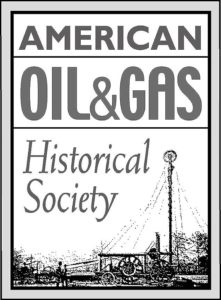by Bruce Wells | Jun 16, 2025 | This Week in Petroleum History
June 16, 1903 – Ford Motor Company Incorporated –
After successfully testing his gasoline-powered Quadricycle in 1896, Henry Ford and a group of investors (including machinist John Dodge) filed articles of association for the Ford Motor Company. Ford’s contributions included machinery, drawings, and several patents. The first sale was a Ford Model A to a Chicago physician in July as the Detroit-based automaker began ordering carriages, wheels, and tires for a low-cost car that would become the Model T by 1908, according to the Henry Ford Heritage Association (HFHA).
June 18, 1889 – Standard Oil of New Jersey adds Indiana
Standard Oil Company of New Jersey incorporated a subsidiary, Standard Oil Company of Indiana, and began processing oil at its new refinery in Whiting, Indiana, southeast of Chicago. In 1910, the refinery added pipelines connecting it to Kansas and Oklahoma oilfields. When the Supreme Court mandated the break up of John D. Rockefeller’s empire in 1911, Standard Oil of Indiana emerged as an independent company. Amoco branded service stations arrived in the 1950s. Amoco merged with British Petroleum (BP) in 1998, the largest foreign takeover of a U.S. company at the time.
June 18, 1946 – Truman establishes National Petroleum Council
At the request of President Harry S. Truman, the Department of the Interior established the National Petroleum Council to make policy recommendations relating to oil and natural gas. Transferred to the new Department of Energy in 1977, the Council became a privately funded advisory committee with 200 members appointed by the Secretary of Energy. “The NPC does not concern itself with trade practices, nor does it engage in any of the usual trade association activities,” notes the NPC, which held its 134th meeting on April 23, 2024, in Washington, D.C.

June 18, 1948 – Service Company celebrates 100,000th Perforation
Fifteen years after its first well-perforation job, the Lane-Wells Company returned to the well at Montebello, California, to perform its 100,000th perforation. The return to Union Oil Company’s La Merced No. 17 well included a ceremony hosted by Walter Wells, chairman and company co-founder.
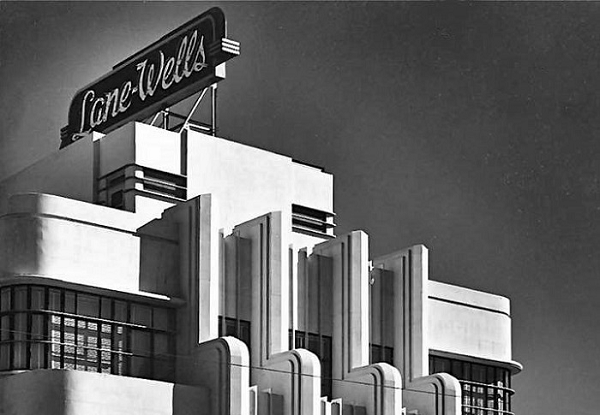
Los Angeles headquarters of Lane-Wells by architect William Mayer, completed in 1937. Photo courtesy Water and Power Associates.
In 1930, Wells and oilfield tool salesman Bill Lane developed a practical multiple-shot perforator that could shoot steel bullets through casing. After many tests, success came at the La Merced No. 17 well. By late 1935, Lane-Wells established a small fleet of trucks for well-perforation services. The company merged with Dresser Industries in 1956 and later became part of Baker-Atlas.
Learn more in Lane-Wells 100,000th Perforation.
June 20, 1977 – Oil begins Flowing in Trans-Alaska Pipeline
The Trans-Alaska Pipeline began carrying oil 800 miles from Prudhoe Bay to the Port of Valdez at Prince William Sound. The oil arrived 38 days later, culminating the world’s largest privately funded construction project. The Prudhoe Bay field had been discovered in 1968 by Atlantic Richfield and Exxon about 250 miles north of the Arctic Circle.
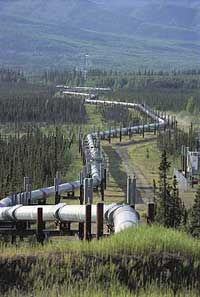
Construction of the controversial pipeline began in 1974. Photo courtesy Alaska Pipeline Authority.
After years of controversy, construction of the 48-inch-wide pipeline began in April 1974. Above-ground sections of the pipeline (420 miles) were built in a zigzag configuration to allow for expansion or contraction and include heat pipes. Oil throughput of the $8 billion pipeline peaked in 1988 at just over 2 million barrels per day, according to the Energy Information Administration (EIA), adding that since 2003, deliveries have been less than 1 million barrels per day and averaged a record low of 464,748 barrels per day in 2024.
“That creates challenges for the pipeline’s operators, including the formation of ice and the buildup of wax that is in the oil on the inside pipeline wall, EIA notes. “The amount of time it takes for oil to travel the 800 miles through the pipeline from the North Slope to the Valdez port increased from 4.5 days in 1988 to about 19 days in recent years.”
Learn more in Trans-Alaska Pipeline History.
June 21, 1893 – Submersible Pump Inventor born
Armais Arutunoff, inventor of the electric submersible pump for oil wells, was born to Armenian parents in Tiflis, Russia. He invented the world’s first electrical centrifugal submersible pump in 1916. At first, Arutunoff could not find financial support for his oilfield production technology after emigrating to the United States in 1923.
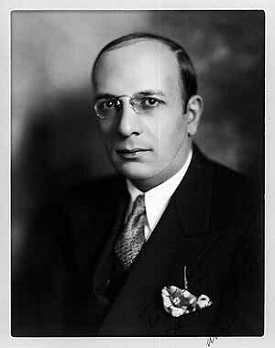
Russian engineer Armais Arutunoff, inventor of the first electric submersible pumps.
Thanks to help from Frank Phillips, president of Phillips Petroleum, Arutunoff moved to Bartlesville, Oklahoma, in 1928 and established a manufacturing company. The Tulsa World described the Arutunoff pump as “An electric motor with the proportions of a slim fencepost which stands on its head at the bottom of a well and kicks oil to the surface with its feet.”
REDA Pump Company manufactured pump and motor devices — and employed hundreds during the Great Depression. The name stands for Russian Electrical Dynamo of Arutunoff, the cable address of his first company in Germany and since 1998 a subsidiary of SLB (Schlumberger).
Learn more in Inventing the Electric Submersible Pump.

June 21, 1932 – Oklahoma Governor battles “Hot Oil”
Thirty National Guardsmen marched into the Oklahoma City oilfield when Governor William H. “Alfalfa Bill” Murray took control of oil production after creating a proration board despite objections from independent producers.
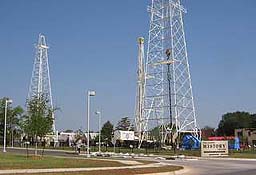
The Oklahoma History Center in Oklahoma City includes petroleum equipment on display in the Devon Energy Park, which opened in 2005. Photo by Bruce Wells.
Murray declared martial law again in March 1933 to enforce his regulations preventing the sale or transport of oil produced in excess of the quota, referred to as “hot oil.”
The state legislature passed a law in April giving the Oklahoma Corporation Commission authority to enforce its rules — taking away Murray’s power to regulate the petroleum industry. The commission had been established in 1907 to regulate railroad, telephone, and telegraph companies.
June 21, 1937 – “Great Karg Well” Marker dedicated in Ohio
Similar to the Indiana natural gas boom, discoveries in Ohio brought petroleum prosperity as evidenced by a 1937 historic marker at one well — “erected in humble pride by the people of Findlay, Ohio,” in celebration of the “Great Karg Well” that revealed a giant natural gas field in January 1886.
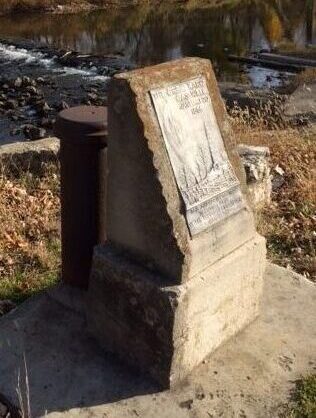
Marker dedicated in 1937 at the wellhead of the famous 1886 natural gas discovery at Findlay, Ohio. Photo by Michael Baker, courtesy Historical Marker Database.
“At that time gas was simply a by-product of oil drilling, and with no way to store it they ended up piping it away for free to heat homes and drive industrial machinery,” notes the historic marker inscription at the wellhead. Many companies promoted Ohio’s natural gas supplies, which “attracted glass companies from around the world” — until the gas ran out.
Learn more in Indiana Natural Gas Boom.
_______________________
Recommended Reading: From Here to Obscurity: An Illustrated History of the Model T Ford, 1909 – 1927 (1971); Standard Oil Company: The Rise and Fall of America’s Most Famous Monopoly
(1971); Standard Oil Company: The Rise and Fall of America’s Most Famous Monopoly (2016); The Prize: The Epic Quest for Oil, Money & Power
(2016); The Prize: The Epic Quest for Oil, Money & Power (2008); Wireline: A History of the Well Logging and Perforating Business in the Oil Fields
(2008); Wireline: A History of the Well Logging and Perforating Business in the Oil Fields (1990)
(1990) ; The Great Alaska Pipeline
; The Great Alaska Pipeline (1988); Artificial Lift-down Hole Pumping Systems
(1988); Artificial Lift-down Hole Pumping Systems (1984); Oil in Oklahoma
(1984); Oil in Oklahoma (1976); Ohio Oil and Gas, Images of America
(1976); Ohio Oil and Gas, Images of America (2008). Your Amazon purchase benefits the American Oil & Gas Historical Society. As an Amazon Associate, AOGHS earns a commission from qualifying purchases.
(2008). Your Amazon purchase benefits the American Oil & Gas Historical Society. As an Amazon Associate, AOGHS earns a commission from qualifying purchases.
_______________________
The American Oil & Gas Historical Society (AOGHS) preserves U.S. petroleum history. Please become an AOGHS annual supporter and help maintain this energy education website and expand historical research. For more information, contact bawells@aoghs.org. Copyright © 2025. Bruce A. Wells. All rights reserved.
by Bruce Wells | Jan 20, 2025 | This Week in Petroleum History
January 20, 1886 – Great Karg Well erupts Natural Gas in Ohio –
A well drilled for oil near Findlay, Ohio, erupted natural gas flowing at 12 million cubic feet per day from pressure that could not be controlled by technologies of the day. The “Great Karg Well” ignited into a flame that burned for four months and became a Findlay tourist attraction. Eight years earlier, a gas well in Pennsylvania had made similar headlines (see Natural Gas is King in Pittsburgh).
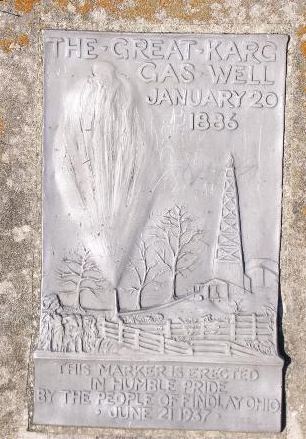
A plaque dedicated in 1937 at Findlay, Ohio, commemorated the state’s 1886 giant natural gas discovery.
Although Ohio’s first natural gas well was drilled in 1884 by the Findlay Natural Gas Company, the Karg well launched a gas-drilling boom that attracted manufacturing industries. Glass works companies were lured by the inexpensive gas (also see Indiana Natural Gas Boom), and new businesses included eight window glass factories, two bottle, two chimney lamp, one light bulb, one novelty, and five for tableware.
By 1887, Findlay was known as the “City of Light,” according to a historical marker erected in 1987 at the first field office of the Ohio Oil Company, which adopted the name Marathon Oil in 1962. The Hancock Historical Museum has preserved Great Karg Well history less than two miles from the well site.
January 21, 1865 – Testing the Roberts Torpedo
Civil War veteran Col. Edward A.L. Roberts (1829-1881) conducted his first experiment to increase oil production by using an explosive charge deep in the well. Roberts twice detonated eight pounds of black powder 465 feet deep in the bore of the “Ladies Well” on Watson’s Flats south of Titusville, Pennsylvania.
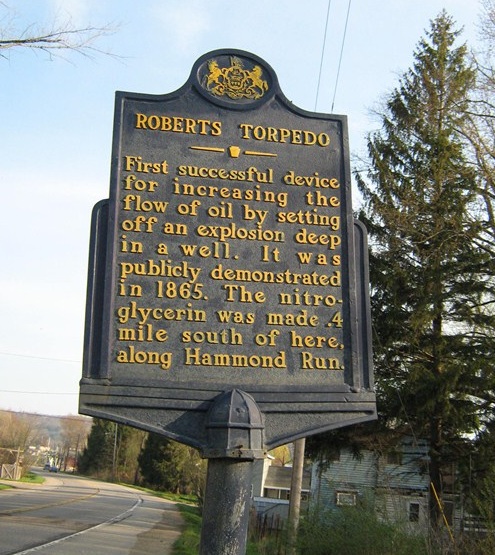
Civil War veteran Col. E.A.L. Roberts demonstrated his oil well “torpedo” south of Titusville, Pennsylvania.
The “shooting” of the well was a success, increasing daily production from a few barrels of oil to more than 40 barrels, according to Pennsylvania Heritage Magazine. By 1870, Roberts’ torpedoes using nitroglycerin became common in oilfields.
In April 1865, Roberts received the first of many patents for his “exploding torpedo,” and one year later the Titusville Morning Herald reported, “Our attention has been called to a series of experiments that have been made in the wells of various localities by Col. Roberts, with his newly patented torpedo. The results have in many cases been astonishing.”

January 22, 1861 – Pennsylvania Stills produce Kerosene
The first U.S. multiple-still oil refinery was brought on-stream one mile south of Titusville, Pennsylvania, by William Barnsdall, who had drilled the second successful well after Edwin Drake’s first U.S. oil discovery. Barnsdall and partners James Parker and W.H. Abbott spent about $15,000 to build six stills for refining kerosene. Equipment was purchased in Pittsburgh and shipped up the Allegheny River to Oil City where a refinery produced two grades of kerosene, white and the less expensive yellow.
January 22, 1910 – Standard Oil of California strikes Oil
Standard Oil Company of California (Socal) drilled its first successful oil well, a gusher in Kern County that initially produced 1,500 barrels of oil a day from the Midway-Sunset field. The discovery came after the 1906 merger of Pacific Coast Oil Company (see First California Oil Well) and Standard Oil Company of Iowa to create Socal.
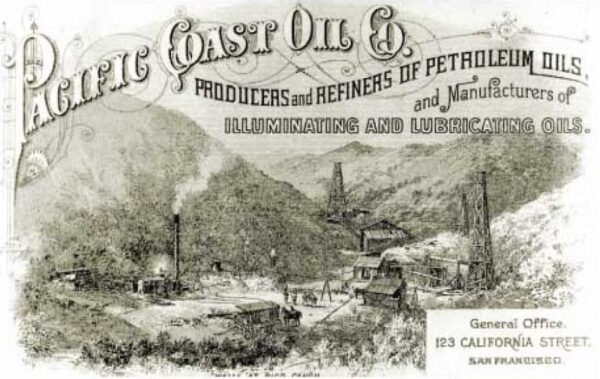
Standard Oil Company of California (Socal) began in 1879 as the Pacific Coast Oil Company and was renamed Chevron in 1981. Image courtesy Chevron.
The new company needed more oil reserves after it had “stepped up its marketing efforts, particularly in gasoline sales, which nearly doubled between 1906 and 1910,” according to a company history. “Until now, Standard had left the hunt for oil to others.”
The U.S. Supreme Court in 1911 ordered Socal separated from its parent, Standard Oil Company of New Jersey. After absorbing Standard Oil of Kansas in 1961 and making other acquisitions, the California company in 1984 rebranded as Chevron, headquartered in San Ramon.

January 23, 1895 – Standard Oil closes Oil Exchanges
Standard Oil Company of New Jersey’s purchasing agency in Oil City, Pennsylvania, notified independent oil producers it would only buy their oil at a price “as high as the markets of the world will justify” — and not “the price bid on the oil exchange for certificate oil.”
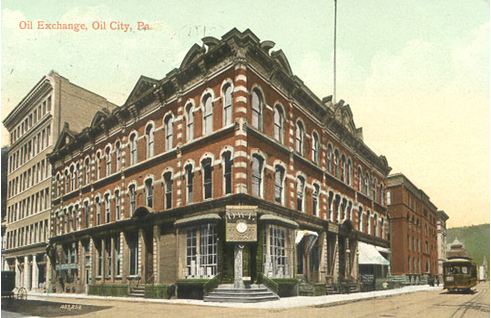
The Oil City, Pennsylvania, Oil Exchange was incorporated in 1874. Three years later, it was the third-largest U.S. financial exchange.
Oil City’s exchange had become the third largest financial exchange of any kind in America, behind New York and San Francisco. But with the Standard Oil Company buying 90 percent of oil production and setting its own price for certificates, all other oil exchanges soon closed.
Learn more in End of Oil Exchanges.
January 23, 1957 – Wham-O launches a New Petroleum Product
Among the earliest mass-produced products made from plastic, the “Frisbee” was introduced by Wham-O Manufacturing Company of California. The polymer toy originated in 1948 when a company called Partners in Plastic sold its “Flyin’ Saucers” for 25 cents each. In 1955, Richard Knerr and Arthur “Spud” Melin’s Wham-O bought the rights.
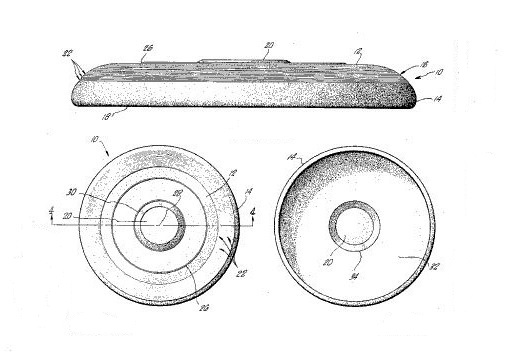
U.S. patent with mold details of a 1967 polyethylene plastic Frisbee.
The Wham-O founders discovered that Phillips Petroleum had invented a high-density polyethylene (called Marlex). They used the new plastic to meet phenomenal demand for manufacturing Frisbees – and Hula Hoops beginning in 1958.
Learn more in Petroleum Product Hoopla.
January 23, 1991 – Gulf War brings World’s Largest Oil Spill
The world’s largest oil spill began in the Persian Gulf when Saddam Hussein’s retreating Iraqi forces opened pipeline valves at oil terminals in Kuwait. About 11 million barrels of oil would cover an area extending 101 miles by 42 miles and reaching five inches thick in some places.
Iraqi soldiers sabotaged Kuwait’s main supertanker loading pier, dumping millions of gallons of oil into the Persian Gulf. By February, about 600 Kuwaiti wells had been set ablaze. It would take months to put out the well fires, with the last extinguished in early April (also see Oilfield Firefighting Technologies).

January 24, 1895 – Independent Producers found Pure Oil
To counter Standard Oil Company’s market dominance, Pennsylvania oil producers, refiners, and pipeline operators organized what would become a major Chicago-based oil venture. Originally based in Pittsburgh, Pure Oil Company quickly grew into the second vertically integrated U.S. petroleum company after Standard Oil.
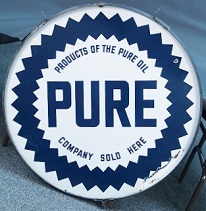
Ohio Cities Gas acquired Pure Oil in 1920 and kept the popular Pennsylvania brand name.
Beginning in early 1896, Pure Oil marketed its petroleum products by horse-drawn tank wagons in Philadelphia and New York — successfully competing with Standard Oil’s monopoly. The Ohio Cities Gas Company of Columbus acquired Pure Oil and in 1920 adopted the former Pennsylvania venture’s brand name.
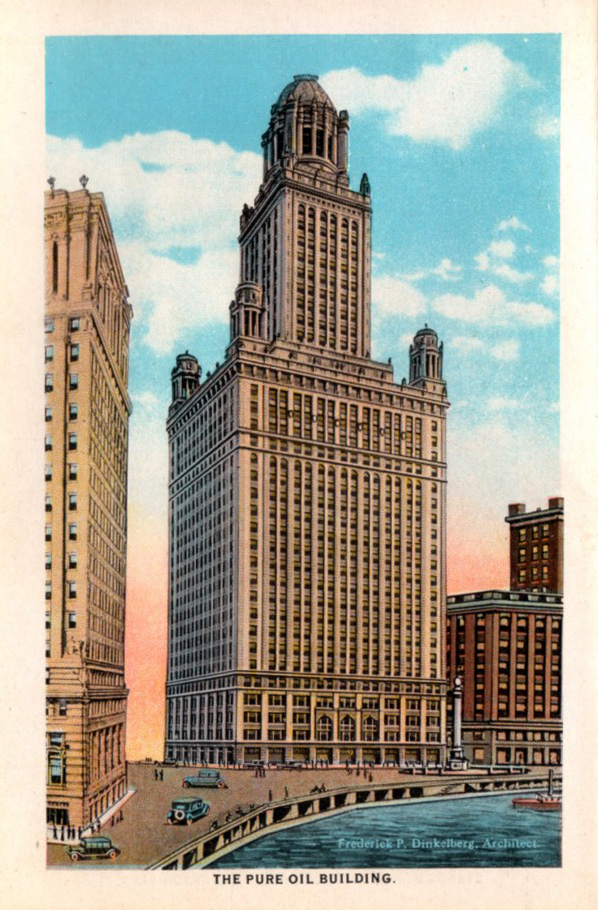
Pure Oil Company moved into its newly built 40-story Chicago headquarters on East Wacker Drive in 1926.
With a new Chicago headquarters opened in 1926, Pure Oil began exploring offshore technologies within a decade. The company developed early freestanding drilling platforms in the Gulf of Mexico.
January 25, 1930 – North Texas Oil Producers form Association
After meeting in Wichita Falls to protest “the recent drastic price cut in crude oil, inaugurated by some of the major purchasing companies,” 50 independent producers organized the North Texas Oil and Gas Association. Other issues included seeking a tariff on foreign oil imports and stopping “hot oil” oilfield thefts. The association merged with the West Central Texas Oil & Gas Association in 1998 to become the Texas Alliance of Energy Producers.

January 26, 1931 – Third Well reveals Extent of East Texas Oilfield
As East Texas farmers struggled to survive the Great Depression, an oil discovery confirmed the existence of a massive oilfield. W.A. “Monty” Moncrief of Fort Worth completed the Lathrop No. 1 well, which produced 7,680 barrels of oil a day from 3,587 feet deep. Geologists at first thought a third oilfield had been found.
Moncrief’s discovery well was 25 miles north of the famous Daisy Bradford No. 3 well of October 1930, drilled by Columbus Marion “Dad” Joiner. It was 15 miles north of the Lou Della Crim No. 1 well, completed at Kilgore three days after Christmas 1930. The 130,000-acre East Texas oilfield would become the largest in the lower 48 states.
Learn more in Moncrief makes East Texas History.
_______________________
Recommended Reading: Myth, Legend, Reality: Edwin Laurentine Drake and the Early Oil Industry (2009); Portrait in Oil: How Ohio Oil Company Grew to Become Marathon
(2009); Portrait in Oil: How Ohio Oil Company Grew to Become Marathon (1962); Ohio Oil and Gas, Images of America
(1962); Ohio Oil and Gas, Images of America (2008); Trek of the Oil Finders: A History of Exploration for Petroleum (1975). Titan: The Life of John D. Rockefeller, Sr.
(2008); Trek of the Oil Finders: A History of Exploration for Petroleum (1975). Titan: The Life of John D. Rockefeller, Sr. (2004); Plastic: The Making of a Synthetic Century
(2004); Plastic: The Making of a Synthetic Century (1996); Against the Fires of Hell: The Environmental Disaster of the Gulf War
(1996); Against the Fires of Hell: The Environmental Disaster of the Gulf War (1992); The Black Giant: A History of the East Texas Oil Field and Oil Industry Skulduggery & Trivia
(1992); The Black Giant: A History of the East Texas Oil Field and Oil Industry Skulduggery & Trivia (2003). Your Amazon purchase benefits the American Oil & Gas Historical Society. As an Amazon Associate, AOGHS earns a commission from qualifying purchases.
(2003). Your Amazon purchase benefits the American Oil & Gas Historical Society. As an Amazon Associate, AOGHS earns a commission from qualifying purchases.
_______________________
The American Oil & Gas Historical Society (AOGHS) preserves U.S. petroleum history. Become an AOGHS annual supporting member and help maintain this energy education website and expand historical research. For more information, contact bawells@aoghs.org. Copyright © 2025 Bruce A. Wells. All rights reserved.



(1971); Standard Oil Company: The Rise and Fall of America’s Most Famous Monopoly
(2016); The Prize: The Epic Quest for Oil, Money & Power
(2008); Wireline: A History of the Well Logging and Perforating Business in the Oil Fields
(1990)
; The Great Alaska Pipeline
(1988); Artificial Lift-down Hole Pumping Systems
(1984); Oil in Oklahoma
(1976); Ohio Oil and Gas, Images of America
(2008). Your Amazon purchase benefits the American Oil & Gas Historical Society. As an Amazon Associate, AOGHS earns a commission from qualifying purchases.













